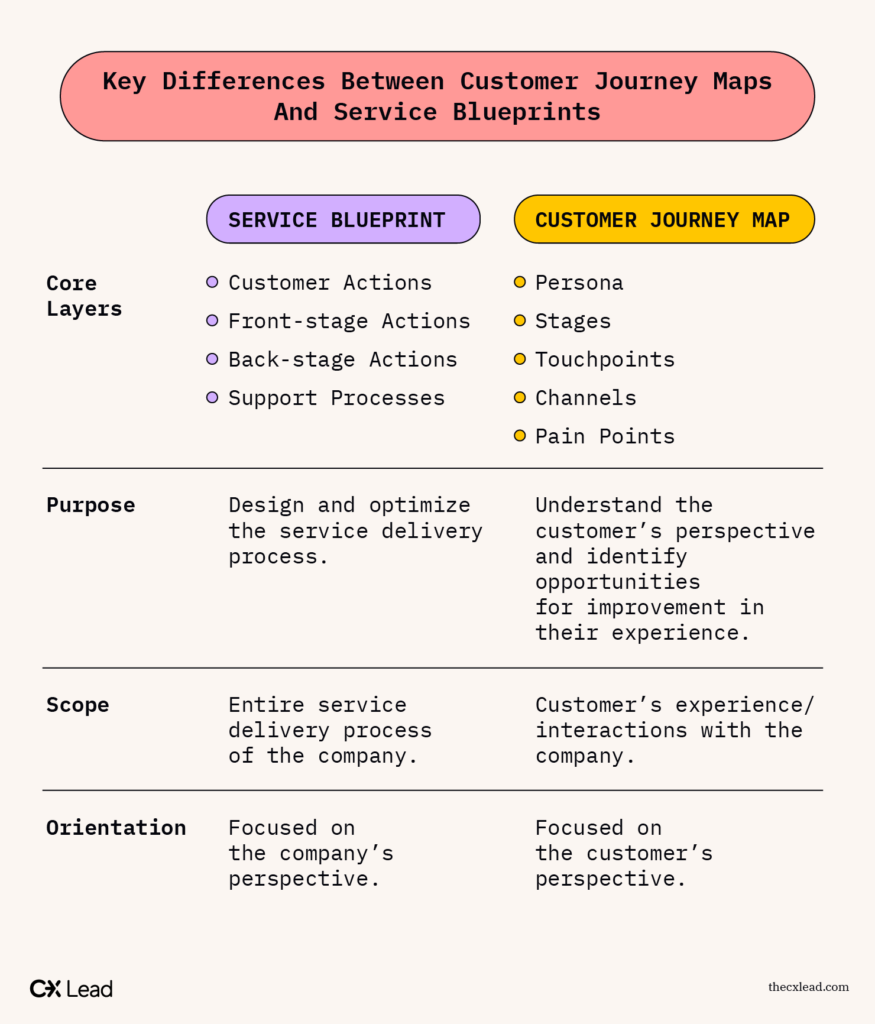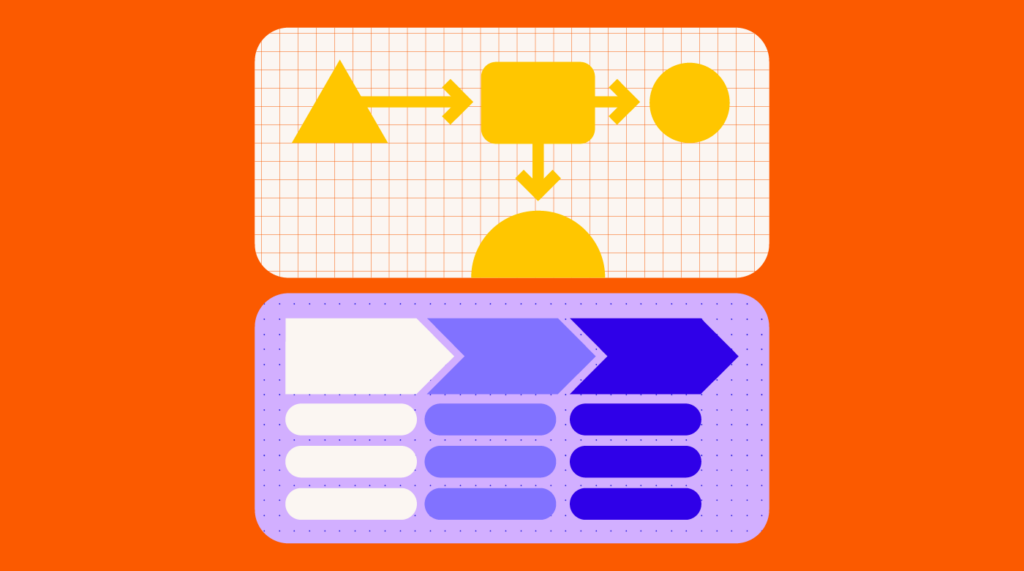Has this ever happened to you? You scour the internet for tools to help inform your customer experience strategy and find a handful. This is great! Look at all of the canvases and flows that you have to choose from. But Instead of gaining momentum, you get stuck. You ask questions to yourself like, Which tool should I start with?
Two common customer experience tools that you likely have come across in this search are the service blueprint and the customer journey map.
With the variety of tools we have at our fingertips, it can be difficult to figure out which one best meets your current business, product, and customer needs. Well fear not, because in this post, I’ll walk you through how to choose between the two core customer experience tools: the service blueprint and the customer journey map.
I’m a research and strategy consultant, who works with clients on becoming more customer-centric and innovative through insights. Before conducting the research, I advise on which methods and CX management tools will best help answer my clients’ questions.
Let’s briefly walk through what service blueprints and customer journey maps are, and highlight their key differences. Then we’ll dive into how to determine which one will work best for you and your problem space.
Service Blueprint vs. Journey Map: What’s The Difference?
What is a Service Blueprint?
A service blueprint is a diagram that breaks down your company’s processes along the customers’ touchpoints with the brand. By looking at the relationships between these service components, you can use this service blueprint strategically to improve your processes and find opportunities for innovation.
There are four main layers within any service blueprint design:
- Customer actions
- Front-stage actions
- Back-stage actions
- Support processes
Let’s break each of these down to understand what they entail.
Customer actions are the steps that the customers themselves take throughout the service delivery process. These actions are the foundation by which the rest of the service blueprint is created because the customers are why your product and/or services exist.
Front-stage actions are the steps taken by employees in their direct encounters with the customer. These actions are typically referred to as face-to-face occurrences, though also include any other form of perceived direct contact that the customer has with people. For example, direct messaging, emails, and video calls.
Back-stage actions are the steps taken by that same employee in the front-stage interactions, but they are what the customer does not see. Some examples of back-stage actions would be what that employee has to do to answer a question for the customer, or collecting assets to hand over to a customer.
Support processes are the activities carried out by employees who don’t have any contact with the customer. Some examples include the developers, marketing, or the operations team. Though farther away from the customer’s actual experience, these employee activities are included in the service blueprint because they are actions that are required for the service to be delivered.
Other supportive elements exist in a service blueprint that allows you to further zero in on the internal processes and how they relate to the customer actions. The most widely used are the line of visibility, props, inventory, flow of actions, roles of people and tools, and swimlanes.
What is a customer journey map?
A customer journey map is a visual representation of the customer's end-to-end experience with a brand, product, or service. It identifies the touchpoints, channels, and phases that the customer goes through as they interact with the company.
By mapping out all of these elements, a company can better understand its customers’ needs, pain points, and opportunities for improvement to deliver a more customer-centric experience. Here are the main elements found in customer journey maps:
- Persona
- Stages
- Touchpoints
- Channels
- Pain points
Let’s talk briefly about each of these core elements.
Personas are fictional characters representing your specific customer segments. They typically include their demographic information, needs, goals, and behaviors. Ideally, each customer journey map you create centers around one persona.
Stages are the different steps that your customer goes through during their journey. Typical high-level stages include awareness, consideration, purchase, and post-purchase. You may have some others that are unique to your offering.
Touchpoints are the specific interactions or points of contact between the customer and the company. Look through all of your channels, website visits, phone calls, emails, or in-person visits to start identifying where your customers are experiencing your brand. Don’t forget actual user behaviour if a product or tool is part of your offering.
Channels are the different communication mechanisms or platforms that the customer can use to interact with the company. Some examples include social media, a website, a mobile app, or a physical store.
Pain points are the obstacles, challenges, or frustrations that the customer faces during their journey, which may cause dissatisfaction or negative experiences. They are an essential aspect of understanding how you can improve CX, so don’t shy away from them.
Some additional elements that are often included in a customer journey map are actions, emotions, opportunities, and key metrics.
Key Differences Between Customer Journey Maps And Service Blueprints
Sometimes these tools can meld into each other a bit, and it can be confusing to keep clear on how they differ. Three key ways to understand how a service blueprint and a customer journey map are different is through their purpose, scope, and orientation.
- Purpose: A service blueprint is used primarily by internal teams to design and optimize the service delivery process, while a customer journey map is used to understand the customer's perspective and identify opportunities for improvement in the customer experience.
- Scope: Service blueprints cover the entire service delivery process including both frontstage and backstage activities as mentioned above. Customer journey maps on the other hand focus on the customer's experience and interactions with the company.
- Orientation: A service blueprint is focused on the company's perspective, while a customer journey map is focused on the customer's perspective. Both do involve the customer’s experience, however, service blueprints touch on internal operations.

How Do I Know Which One I Need?
Are you wondering which tool best suits your current needs? The key differences mentioned above may help you navigate this. I also find that sometimes we jump to solutions much quicker before understanding the problem space. In being clear on what you are trying to solve, you’ll be able to choose the right tool to help you get there.
Therefore, the first question to ask yourself is, what are your company’s most significant challenges to date? If the nature of these challenges is more about your company’s internal processes, then a service blueprint is likely your best bet. If right now you’re looking to understand the customer’s experience, then you’re headed more toward a customer journey map.
The answer to this question may even be, I need both. If you are in a situation where you are in the early stages of building CX into your company’s practice, these next few tips may help you get moving:
- Get focused. Though many ideas are nice to have, start with the one that will help you solve your core problem right now.
- Take stock of your timeframe. If you’re looking for quick wins, a customer journey map could be good to start with as it is relatively less complex.
- Ease in. A customer journey map is also good to start with if you are new to working with these tools. Once you get comfortable with that, you can then move into the service blueprint.
Finally, in some cases, it may be useful to start with a service design blueprint and a customer journey map. They both provide complementary insights into the service delivery process and customer experience and may help inform one another.
Choose the Right Service Design Tool for You!
There you have it. I hope that this article has helped you feel more confident in choosing which tool to start with. If you’re looking for some other quality service design tools to build your work through, take a look at this list of design thinking tools.
If you want to stay up to date with all things customer experience, subscribe to the CX Lead newsletter!


